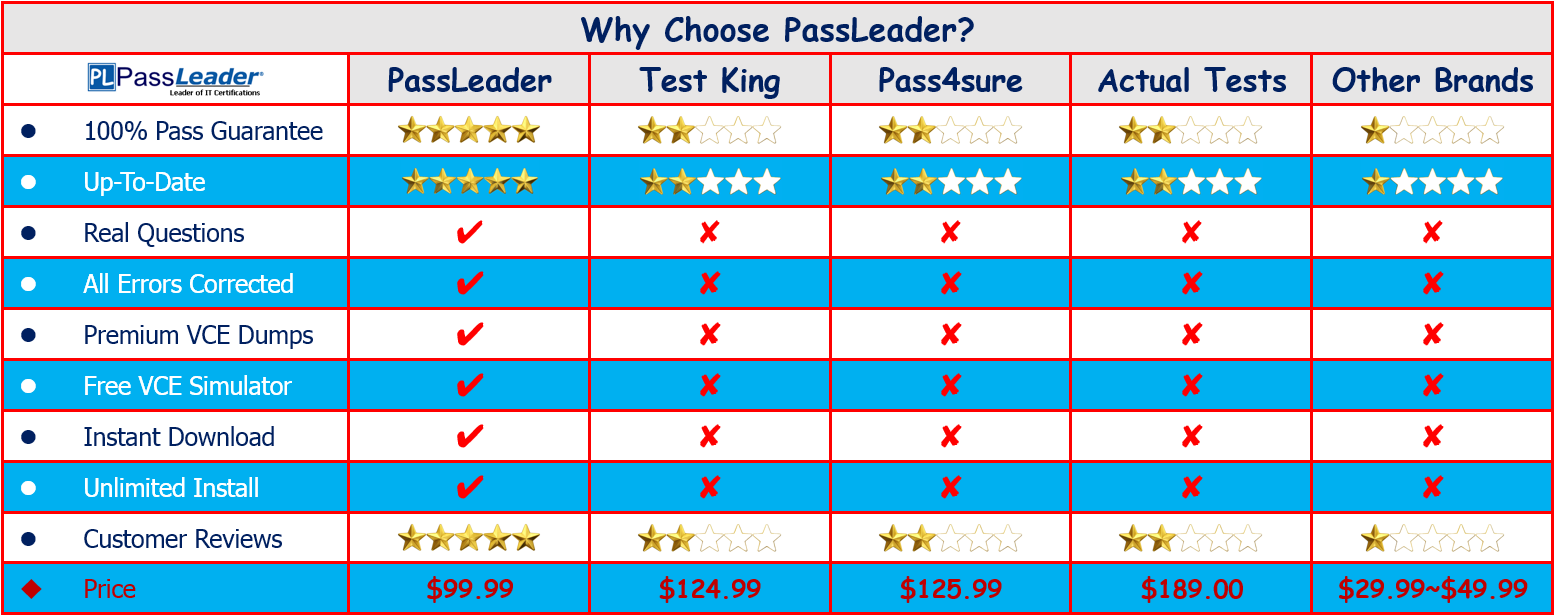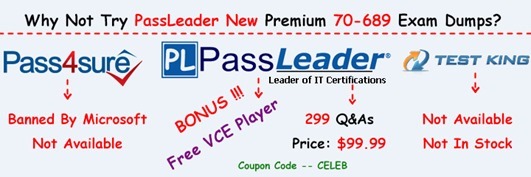Get New Valid Dumps To Pass Exam 70-689: The following new 70-689 exam questions were updated in recent days by PassLeader, visit passleader.com to get the full version of new 299q 70-689 exam dumps with free version of new VCE Player software, our valid 70-689 briandump will help you passing 70-689 exam easily! PDF practice test and VCE are all available now!
keywords: 70-689 exam,70-689 exam dumps,299q 70-689 exam questions,70-689 pdf dumps,70-689 vce dumps,299q 70-689 braindump,70-689 practice test,Upgrading Your Skills to MCSA Windows 8 exam
QUESTION 171
You have a computer that runs Windows 8. The computer has a shared folder named C:\Marketing. The shared folder is on an NTFS volume. The current NTFS and share permissions are configured as follows: 
UserA is a member of both the Everyone group and the Marketing group. UserA must access C:\Marketing from across the network. You need to identify the effective permissions of UserA to the C:\Marketing folder. What permission should you identify?
A. Read
B. Full Control
C. Modify
D. Read and Execute
QUESTION 172
Drag and Drop Questions
You support a desktop computer that runs Windows 8 Pro. The computer is joined to an Active Directory domain. The computer has a folder named C:\Reports. The folder NTFS permissions are shown in Exhibit 1. (Click the Exhibit button.) 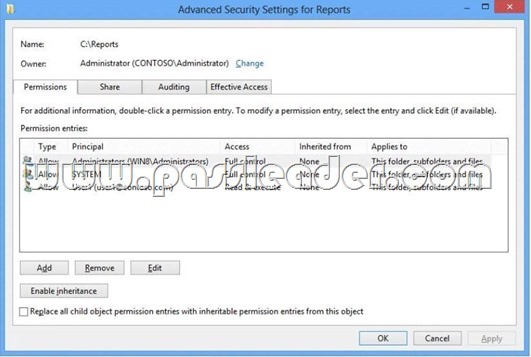
The folder is shared over the network with Read permission for a domain user account named User1 as shown in Exhibit 2. (Click the Exhibit button.)
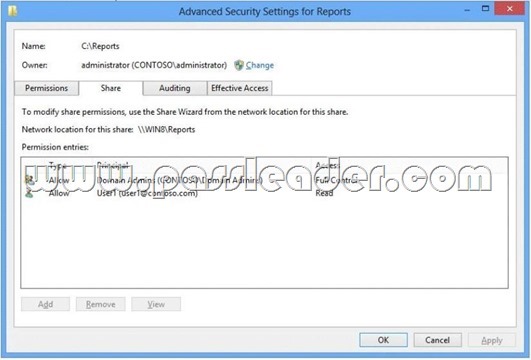
Members of the domain security group named Accountants must have access to the shared folder. You need to assign the required permissions. Which three actions should you perform in sequence? (To answer, move the appropriate actions from the list of actions to the answer area and arrange them in the correct order.) 
Answer: 
QUESTION 173
You administer laptops that run Windows 8 Enterprise. The laptops are members of an Active Directory domain and are configured with IPv6 disabled. Some users require access to the internal company database servers while traveling. You need to configure the requested network connection to the database servers. What should you configure on the laptops?
A. A DirectAccess connection to the company network
B. A virtual private network (VPN) connection to the company network
C. A metered network connection
D. Out of band management
Answer: B
QUESTION 174
You have a desktop computer that runs Windows 8 Enterprise. You add three new 3-terabyte disks. You need to create a new 9-terabyte volume. Which two actions should you perform? (Each correct answer presents part of the solution. Choose two.)
A. From Disk Management, create a new spanned volume.
B. From Disk Management, convert all of the 3-terabyte disks to GPT.
C. From PowerShell, run the New-VirtualDisk cmdlet.
D. From Disk Management, bring all disks offline.
E. From Diskpart, run the Convert MBR command.
F. From PowerShell, run the Add-PhysicalDisk cmdlet.
Answer: BE
QUESTION 175
You administer laptop and desktop computers that run Windows 8 Pro. Your company uses Active Directory Domain Services (AD DS) and Active Directory Certificate Services (AD CS). Your company decides that access to the company network for all users must be controlled by two-factor authentication. You need to configure the computers to meet this requirement. What should you do?
A. Install smart card readers on all computers. Issue smart cards to all users.
B. Enable the Password must meet complexity requirements policy setting. Instruct users to log on by using the domain \username format for their username and their strong password.
C. Create an Internet Protocol security (IPsec) policy that requires the use of Kerberos to authenticate all traffic. Apply the IPsec policy to the domain.
D. Issue photo identification to all users. Instruct all users to set up and use PIN Logon.
Answer: A
QUESTION 176
You administer computers that run Windows 8 Enterprise and are members of an Active Directory domain. Some volumes on the computers are encrypted with BitLocker. The BitLocker recovery passwords are stored in Active Directory. A user forgets the BitLocker password to local drive E: and is unable to access the protected volume. You need to provide a BitLocker recovery key to unlock the protected volume. Which two actions should you perform? (Each correct answer presents part of the solution. Choose two.)
A. Ask the user to run the manage-bde -protectors-disable e: command.
B. Ask the user for a recovery key ID for the protected drive.
C. Ask the user for his or her logon name.
D. Ask the user for his or her computer name.
Answer: AC
QUESTION 177
Drag and Drop Questions
You support desktop computers for a company named Fabrikam, Inc. The computers are members of the Active Directory domain named fabrikam.com. Fabrikam works with a supplier named Contoso, Ltd. Each company has a public key infrastructure (PKI), and no public certificate authorities (CAs) are used. Fabrikam employees regularly use a Contoso website that is hosted on a server in the contoso.com domain. The website requires SSL and mutual authentication. You need to configure the computers to allow Fabrikam users to access the Contoso website without any warning prompts. You also need to use the fewest certificates possible. Which certificate or certificates should you use? (To answer, drag the appropriate certificate to the correct certificate store. Each certificate may be used once, more than once, or not at all. You may need to drag the split bar between panes or scroll to view content.) 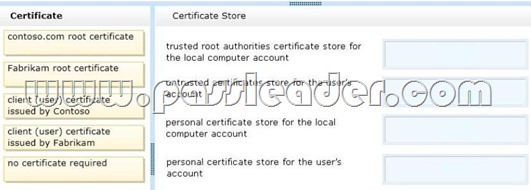
Answer: 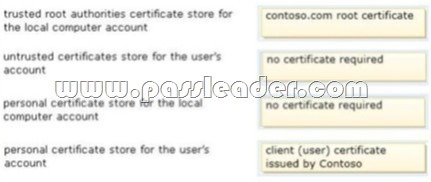
QUESTION 178
You administer computers that run Windows 8 Enterprise. The computers are members of an Active Directory domain. You have a tablet that runs Windows 8 Enterprise. You configure the tablet to access your company network by using a virtual private network (VPN) connection. You need to manage Active Directory from the tablet by using a VPN connection. What should you do?
A. Run the winrm.exe qc command.
B. Install the System Center Configuration Manager (SCCM) 2012 client.
C. Install the Remote Server Administration Tools (RSAT).
D. Install the Windows Intune client.
Answer: C
QUESTION 179
You support tablets that run Windows 8 Pro. You are designing a remote access server (RAS) that will be placed behind a firewall. The firewall will accept incoming TCP connections to ports 80 and 443 only. You want to connect to the RAS server from a tablet. You need to create a virtual private network (VPN) connection to the RAS server. Which VPN tunneling protocol should you use?
A. IPSec/L2TP
B. SSTP
C. PPTP
D. IPSec/IKEv2
Answer: B
QUESTION 180
You are a systems administrator of a small branch office. Computers in the office are joined to a Windows 8 HomeGroup. The HomeGroup includes one shared printer and several shared folders. You join a new computer to the HomeGroup and try to access the HomeGroup shared folders. You discover that the shared folders are unavailable, and you receive an error message that indicates the password is incorrect. You need to reconfigure the new computer in order to access the HomeGroup resources. What should you do?
A. Adjust the time settings on the new computer to match the time settings of the HomeGroup computers.
B. Change the HomeGroup password and re-enter it on the computers of all members of the HomeGroup.
C. Change the default sharing configuration for the shared folders on the HomeGroup computers.
D. Reset your account password to match the HomeGroup password.
Answer: A
http://www.passleader.com/70-689.html
QUESTION 181
You are a systems administrator for Contoso; Ltd. All client computers run Windows 8 and are members of the contoso.com Active Directory domain. Users log on to their computers by using domain user accounts. Contoso develops an internal line of business (LOB) Windows Store app. You want to deploy the LOB app to the client computers and configure the app to access various resources in the domain. You need to enable all users to run the LOB app and access the required resources from the LOB app. What should you do?
A. Certify the LOB app with Windows Store.
Ask users to log on to their computers by using a Microsoft Account.
Install the LOB app from Windows Store.
Ask users to log off, and then log back on in by using their domain accounts.
B. Restart each computer by using WinPE.
From WinPE, copy all of the LOB app executable files in the Program Files folder.
Restart into Windows 8 and ask users to log on by using their domain accounts.
C. Use the DISM utility to include the LOB app in a new Windows 8 image.
Reimage the computers with the new image.
Join the computers to a new workgroup.
Ask each user to log on to the computer by using a new Microsoft Account that ends with @contoso.com.
D. Configure the Allow all trusted apps to install policy settings for all computers.
Ask users to log on by using their domain accounts, and then execute a PowerShell script that includes
the add- appxpackage cmdlet.
Answer: A
QUESTION 182
You administer a company network that includes a wireless network infrastructure and computers that run Windows 8 Enterprise. You are planning to add a guest wireless network. You need to collect information about nearby wireless networks, including their encryption methods. Which command should you include in the batch file?
A. Netsh wlan set autoconfig enabled=no interface="Wireless Network Connection"
B. ipconfig /allcompartments
C. Get-WmiObject win32_networkadapterconfiguration -Filter ‘ipenabled = "true"’
D. netsh wlan show networks
E. netsh wlan show hostednetwork
F. netstat -a
Answer: D
QUESTION 183
Drag and Drop Questions
You administer desktop computers that run Windows 8 Enterprise and are members of an Active Directory domain. A new security policy states that all traffic between computers in the research department must be encrypted and authenticated by using Kerberos V5. You need to configure the requested traffic authentication settings by using Windows Firewall with Advanced Settings. Which three actions should you perform in sequence? (To answer, move the appropriate actions from the list of actions to the answer area and arrange them in the correct order.) 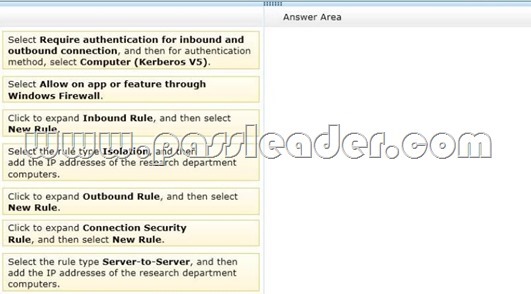
Answer: 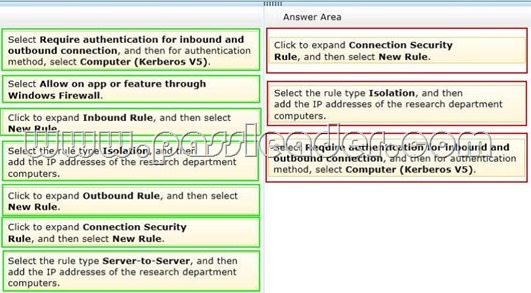
QUESTION 184
You support desktop computers and tablets that run Windows 8 Enterprise. All of the computers are able to connect to your company network from the Internet by using DirectAccess. Your company wants to deploy a new application to the tablets. The deployment solution must meet the following requirements:
– The application is stored locally on the tablets.
– Access to the application is protected with extra logon credentials, in addition to a standard domain account used by users.
– The application utilizes the least amount of network bandwidth.
– The application must maintain access to the current desktop.
You need to deploy the new application to the tablets. What should you do?
A. Deploy the application as an Application Virtualization (App-V) package. Install the App-V 4.6 client on the tablets.
B. Deploy the application as a published application on the Remote Desktop server. Create a Remote Desktop connection on the tablets.
C. Install the application on a local drive on the tablets.
D. Install the application in a Windows To Go workspace.
E. Install Hyper-V on tablets. Install the application on a virtual machine.
F. Publish the application to Windows Store.
G. Install the application within a separate Windows 8 installation in a virtual hard disk (VHD) file. Configure the tablets with dual boot.
H. Install the application within a separate Windows 8 installation in a VHDX file. Configure tablets with dual boot.
Answer: E
QUESTION 185
You support desktop computers and tablets that run Windows 8. Domain joined computers are able to connect to your company network from the Internet by using DirectAccess. Your company wants to deploy a new application to the tablets. The deployment solution must meet the following requirements:
– The application is installed locally on the tablets.
– The application installation is hosted in a public cloud.
– The installation must support Windows RT.
You need to deploy the new application to the tablets. What should you do?
A. Deploy the application as an Application Virtualization (App-V) package. Install the App-V 4.6 client on the tablets.
B. Deploy the application as a published application on the Remote Desktop server. Create a Remote Desktop connection on the tablets.
C. Install the application on a local drive on the tablets.
D. Install the application in a Windows To Go workspace.
E. Install Hyper-V on tablets. Install the application on a virtual machine.
F. Publish the application to Windows Store.
G. Install the application within a separate Windows 8 installation in a virtual hard disk (VHD) file. Configure the tablets with dual boot.
H. Install the application within a separate Windows 8 installation in a VHDX file. Configure tablets with dual boot.
Answer: F
QUESTION 186
You support desktop computers and tablets that run Windows 8 Enterprise. All of the computers are able to connect to your company network from the Internet by using DirectAccess. Your company wants to deploy a new application to the tablets. The deployment solution must meet the following requirements:
– The application is not accessible if a user is working offline.
– The application is isolated from other applications.
– The application uses the least amount of disk space.
You need to deploy the new application to the tablets. What should you do?
A. Deploy the application as an Application Virtualization (App-V) package. Install the App-V 4.6 client on the tablets.
B. Deploy the application as a published application on the Remote Desktop server. Create a Remote Desktop connection on the tablets.
C. Install the application on a local drive on the tablets.
D. Install the application in a Windows To Go workspace.
E. Install Hyper-V on tablets. Install the application on a virtual machine.
F. Publish the application to Windows Store.
G. Install the application within a separate Windows 8 installation in a virtual hard disk (VHD) file. Configure the tablets with dual boot.
H. Install the application within a separate Windows 8 installation in a VHDX file. Configure the tablets with dual boot.
Answer: B
QUESTION 187
You support desktop computers and tablets that run Windows 8 Enterprise. All of the computers are able to connect to your company network from the Internet by using DirectAccess. Your company wants to deploy a new application. The deployment solution must meet the following requirements:
– The application does not utilize the company server infrastructure.
– The application is isolated from other applications.
– The application uses the least amount of disk space possible on a solid-state drive (SSD) on the tablets.
– The application utilizes the least amount of network bandwidth.
You need to deploy the new application to the tablets. What should you do?
A. Deploy the application as an Application Virtualization (App-V) package. Install the App-V 4.6 client on the tablets.
B. Deploy the application as a published application on the Remote Desktop server. Create a Remote Desktop connection on the tablets.
C. Install the application on a local drive on the tablets.
D. Install the application in a Windows To Go workspace.
E. Install Hyper-V on tablets. Install the application on a virtual machine.
F. Publish the application to Windows Store.
G. Install the application within a separate Windows 8 installation in a virtual hard disk (VHD) file. Configure the tablets with dual boot.
H. Install the application within a separate Windows 8 installation in a VHDX file. Configure tablets with dual boot.
Answer: D
QUESTION 188
You administer laptop and desktop computers that run Windows 8 Enterprise in an Active Directory domain. Your company has purchased a subscription to Windows Intune. You plan to install Intune Endpoint Protection on all computers. Some of the computers also have another antimalware application installed. You need to ensure that only the Intune Endpoint Protection application is running on all computers. What should you do?
A. Configure the Enable Realtime Protection policy to Yes.
B. Configure the Enable Endpoint Protection policy to Only on computers that are unprotected when Endpoint Protection is installed.
C. Configure the Enable Endpoint Protection policy setting to Yes.
D. Configure the Enable Endpoint Protection policy setting to No.
Answer: C
QUESTION 189
Your company has purchased a subscription to Windows Intune. You use Windows Intune to automatically deploy Windows updates. You create an automatic approval rule in Windows Intune but notice that previously existing updates are not deployed. You need to ensure that all previously existing updates are automatically approved. What should you do?
A. Run the approval rule.
B. Edit the schedule for the automatic approval rule.
C. Create and deploy a policy that uses the recommended settings in the Windows Intune Center Settings template.
D. Create and deploy a custom policy in the Windows Intune Center Settings template.
Answer: A
QUESTION 190
You administer computers that run Windows 8 Pro. The desktops have the Application Virtualization (App-V) client installed. Multiple App-V applications are published on the network. A user reports that it is taking a long time to launch App-V applications on his computer. You discover that the user has a roaming profile on the computer. You need to minimize the time that is required for the user to start App-V applications on the computer. What should you do?
A. Change the user profile to Super-Mandatory.
B. Change the location of the App-V client cache file on the computer.
C. Increase the size of the App-V client cache on the computer.
D. Change the user profile to Local.
Answer: C
http://www.passleader.com/70-689.html
